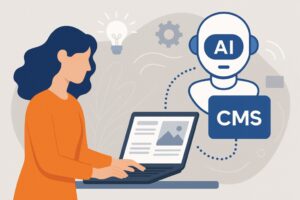The future of content creation in a headless CMS world is powered by AI. With the demand for ultra-engaging, personalized, and meaningful digital experiences, organizations will harness the power of AI in a headless CMS to transform content strategy and production effectiveness while engaging the target audience like never before. This article discusses the future of content creation in an AI environment for headless CMS by assessing what is possible.
Intelligent Content Creation and Automation
Perhaps the most important feature that AI will bring to headless CMS is intelligent content creation. With natural language processing (NLP) and generative AI models trained on thousands of sources, for example, content creators will be able to create draft articles automatically, get dynamic variations of the same piece, or generate updates while they type. Adopting a Sanity open source alternative can further enhance these AI-driven capabilities by offering greater customization and flexibility. Such features offer streamlined processes, increased productivity, and real-time scalability of content, allowing organizations to continue churning out fresh and relevant pieces across channels without a loss in quality or excessive manual labor.
Improved Personalization and Contextualization
AI-integrated headless CMS can vastly improve personalization and contextualization features; leaps and bounds ahead of mere tagging and categorizations. AI can assess vast quantities of data generated by online users, search trends, preferences, past interactions and offer content recommendations at the most precise and real-time levels possible. This enhances the accuracy of personalized content suggestions to a level beyond human capabilities and assists audiences in connecting with appropriate content on meaningful levels which breeds appreciation and loyalty.
Predictive Analytics for Savvy Content Strategy and Integration
Implementing predictive analytics via AI-driven headless CMS increases chances for a savvy content strategy and integration. For example, AI can predict what audiences want based on previous deployments and how content pieces will trend over time or at specific delivery times. This empowers content teams to adjust their approaches ahead of time for the best possible outcome. In addition, predictive analytics help champion the right content topic, format or delivery time to ensure appropriate resources are allocated from the start, maximizing engagement down the line for overarching success.
Opportunities for Real-Time Audience Feedback and Content Revisions
AI-reinforced headless CMS fosters opportunities for real-time audience feedback decoding which helps creators and management make content delivery decisions based on instant reactions. Whether through real-time monitoring or feedback loops, companies within any industry can continuously receive feedback about current campaigns or success/failure of message bites related to larger campaigns. Therefore, adjustments can be made on the fly to improve messaging or take advantage of unforeseen opportunities which champions a fluid content strategy over a static process and helps brands sound more relevant in real time.
Enhanced Digital Asset Management and Image Tagging
Similarly, AI further improves digital asset management offered by headless CMS. For example, image tagging and sophisticated image recognition ease the process when working with rich media libraries as they automatically tag assets and require less manual time spent searching for and categorizing images. Thus, for example, editors can easily find, reuse, and publish necessary digital assets at rapid speeds, improving internal workflow and enhancing content output. Improved discoverability also leads to higher consistency, aesthetics, and effectiveness across various digital touchpoints.
Voice and Conversational Interfaces
The future of content creation transcends beyond written and visual formats. Content management systems (CMS) in a headless environment with AI capabilities allow positioning content for voice and conversational interfaces, think chatbots, virtual assistants, voice and audio platforms as options. Natural language processing (NLP) technology allows for the development of engaging conversational content that reflects brand voice/message consistency while providing personalized experiences across varied avenues of conversation to reach a broader audience and enhance user experience.
Content Accessibility and Inclusivity
AI developments within a headless CMS allow for accessibility and inclusivity of content like never before. With automated transcription, translation, and alt-text generation, companies can quickly create accessible content for multiple user bases, regulatory agencies, and international market needs. Better accessibility equals inclusivity which fosters company reputation while expanding potential audiences as brands striving to be socially responsible are thought leaders in their industries.
Improved Review and Quality Control of Content
Using AI within headless CMS solutions improves the review and quality control of content. Automated proofreading, grammar analysis, and tonal adjustments keep content consistent and at a higher caliber with less strain on human resources. Furthermore, quality assessment tools assess content for legal compliance or internal brand standards, easing review processes, minimizing errors, and protecting an organization’s reputation across digital experiences.
Enhanced Collaboration Across Departments
Headless CMS options that include AI capabilities create enhanced collaboration across departments with content creators, marketers, developers, and strategists alike. Intelligent, automated recommendations for content and central hubs for collaboration ease team efforts across the board while improved workflow monitoring reduces communication silos. Collaborative improvements help teams rapidly adjust and deploy for testing and launch content, increasing innovation speed to market, operational efficiencies, and cross-department strategic alignment.
Adaptive Content Experiences in Emerging Technologies
With the rise of AI in headless CMS, organizations are poised to create immensely responsive, contextual content experiences across nascent digital environments augmented reality (AR), virtual reality (VR), and mixed reality (MR). With AI functionality, organizations can guarantee that their content adapts not only to a user’s context and needs but also the specific abilities and needs of devices, systems and settings.
For example, AI content can be adaptive by responding to how a user holds their phone, the lightness or darkness of an environment, their previous interactions or the speed in which they engage with certain features. Such adjustments enable truly compelling and immersive experiences.
Thus, by managing when and how content is presented in real time, AI-driven headless CMS can improve the experience when emerging and increasingly complex manifestations of digital environments are involved. Thus, in AR, content can adjust on the fly to legitimate interactions with physical objects, overlaid seamlessly to contextualize virtual elements. In VR, responsive content relies upon AI to create realigned experiences based on user engagement, interest and interaction level while it’s happening to promote more realism and impact.
In MR, digitally integrated experiences exist more fluidly as AI-based CMS can manipulate content dynamically depending on user movements, vocal interactions or even detection from outside environmental changes via connected technology.
Furthermore, AI-driven dynamic intelligence renders content creators in a position to predict and fulfill an even broader range of use cases, meaning that every experience is just as engaging. Companies can preemptively customize content for geographic regions, preferred languages, cultural distinctions, device capabilities, and even real-time weather changes meaning that what may be perfectly acceptable in one digital realm may not make sense in another, creating intimate, personal digital journeys that uphold interest and relevance with every user.
Such personalization and context-driven engagement fosters better engagement, satisfaction, and loyalty as users develop deeper emotional investments and connections to brands.
Improved Security and Compliance with AI
Security and compliance are always priorities when it comes to digital content. Adopting an AI-based headless CMS solution creates a more secure environment through automated anomaly detection, real-time tracking and adjustments, and risk evaluation. For example, an AI-based headless CMS could assess behavioral patterns of the typical user every day. If something differs from the norm, it flags potential vulnerabilities to the management team. It can also maintain compliance with GDPR or CCPA on automatic review for necessary updates. Thus, improved security elements protect sensitive content, maintain consumer confidence and brand reputation.
Additional Implementation Options for a Headless CMS with AI
While AI can be incredibly beneficial for many organizations eager to implement a headless content management system, there are certain challenges or issues that companies need to consider prior to implementation. These risks may include, but are not limited to, data privacy issues, HR bias, and integration challenges. When companies ensure ethical practices in Artificial Intelligence, transparency in algorithms and integration within specific processors reduces concerns; continuous workforce training championed by governance boards and care in vendor selection allow organizations to create ethical, transparent approaches beyond transaction purposes for responsible use of adopted technology.
AI-Powered Headless CMS as the Future of Content Creation
The use of artificial intelligence in conjunction with headless content management systems (CMS) is a major revolutionary shift in digital content generation efforts, transforming previously established processes and redefining new innovations. Whereas traditional content creation possibilities extended only so far, the ability to capitalize on AI technologies including natural language processing, machine learning, predictive analytics, and advanced personalization within a powerful headless CMS creates unprecedented levels of efficiency, relevancy, time and output flexibility, and scalability.
Such a blend empowers organizations to pursue more than just static content creation efforts; the ability to engage in real-time, personalized strategies that adapt to single user behavior and market fluctuations occur in a manner never before possible.
With AI integration into headless CMS tools, organizations become equipped with the skills necessary to thrive even when uncertainties abound. For example, real-time analytical data provide insights previously unknown to content teams; audiences may not even be aware of the trends they’re establishing until an analysis brings it to light, enabling proactive adjustment of content strategies.
Furthermore, AI provides tools through which organizations can fine-tune content based on individual preferences established over time, relevant social triggers, and other environmental circumstances so that each interaction is as meaningful as possible.
Furthermore, the use of AI enhances content creation efficiencies, reducing the need for manual labor, decreasing the potential for human error, and increasing content quality and consistency. With automated content production features along with smart editing and quality control solutions companies can dramatically reduce content creation turnaround times while simultaneously achieving new heights of quality. Such efficiencies in operations allow teams to scale their content efforts quickly, address new opportunities with urgency, and redirect resources appropriately to more creative, high-value endeavors.
Moreover, the flexibility and scalability that AI-driven headless solutions provide make it simple to integrate new technologies and platforms that have yet to emerge into the digital ecosystem, including augmented reality, virtual reality, voice-based interactions, conversational interfaces and more IoT-related devices.
Companies can easily add these evolving platforms to their existing digital solutions seamlessly, supported by intelligent methods of content delivery that automatically adjust experiences based on analytics and predictive learning. Such adaptability prepares companies for the future and gives them the confidence to stay ahead of technological advancements, ensure they meet customer expectations as they evolve, and sidestep digital disruptions.
Ultimately, the organizations that will be best suited to not just survive but thrive in the future of content creation will be those who implement AI driven headless CMS platforms. Such a plan will ensure these organizations are always ahead of the game when it comes to effective content presentation in diverse formats and through multiple channels and endpoints, driving consistent audience engagement, effective competitive advantage, and strategic success over time. As the digital world evolves rapidly, those who implement AI into the headless CMS platform will be flexible, creative and strong enough to continually meet customer needs with successful growth and maintain relevance.








